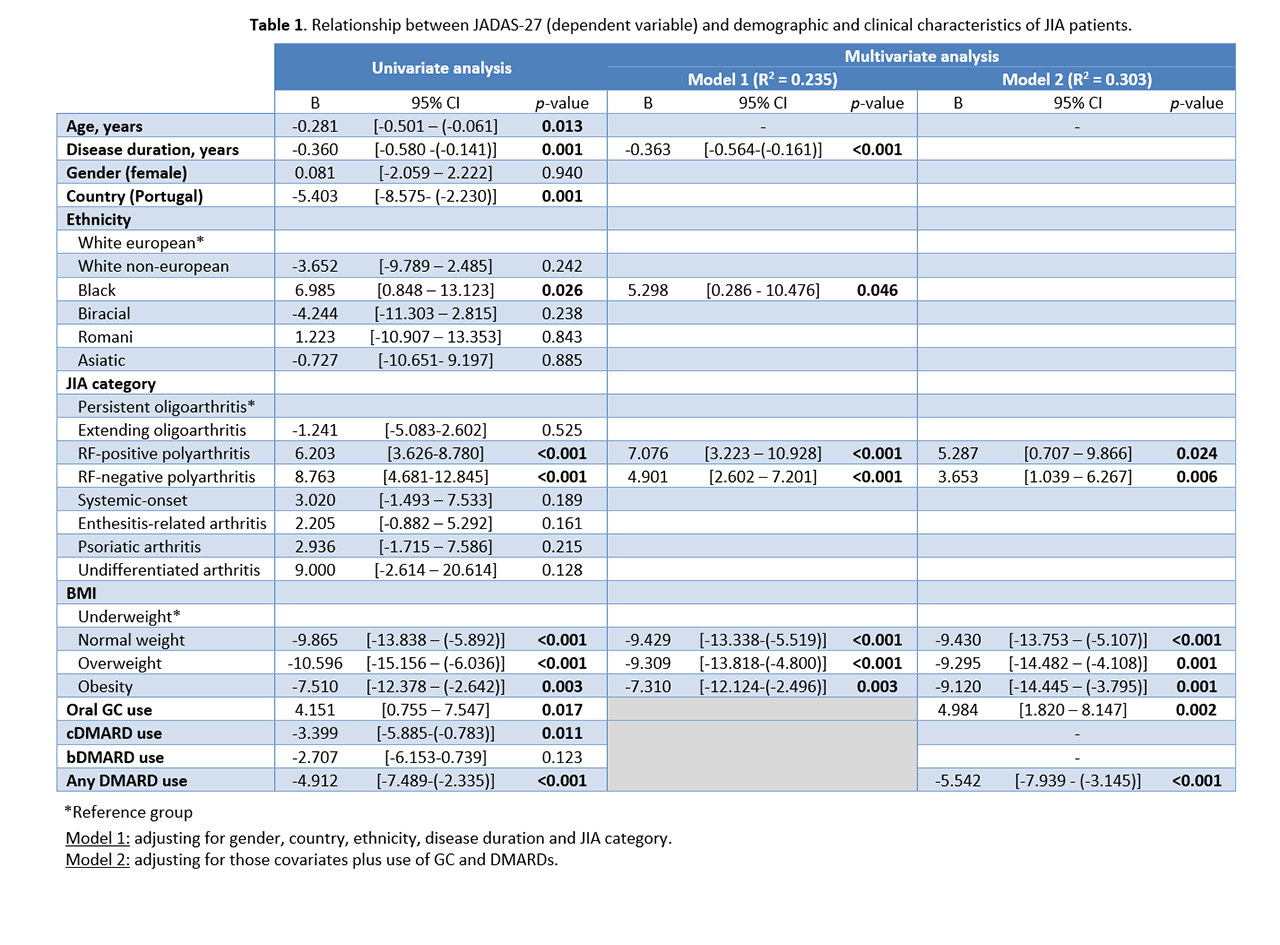Session Information
Date: Tuesday, November 12, 2019
Title: Pediatric Rheumatology – ePoster III: Systemic JIA, Fever, & Vasculitis
Session Type: Poster Session (Tuesday)
Session Time: 9:00AM-11:00AM
Background/Purpose: In adults with Rheumatoid Arthritis, obesity has been associated with higher disease activity. However, in Juvenile Idiopathic Arthritis (JIA), the influence of body mass index (BMI) on disease activity is uncertain and a previous study has failed to find any association. We aim to clarify the relationship between BMI and JIA disease activity.
Methods: An international, multicenter, observational analysis was conducted. JIA patients (according to ILAR criteria) aged ≤ 18 years, registered at Rheumatic Diseases Portuguese Register (Reuma.pt) in Portugal and Brazil were included. Anonymized data of the first registered visit was analyzed. Age- and sex-specific BMI percentiles (P) were calculated based on WHO growth standard charts and categorized into underweight (P< 3), normal weight (3≤P≤85), overweight (85< P≤97) and obesity (P >97). Disease activity was assessed by Juvenile Arthritis Disease Activity Score (JADAS-27). Univariate linear regression was used to examine the association of BMI categories with JADAS-27. Two multivariate regression models were performed: a) adjusting for gender, ethnicity, country, disease duration and JIA category (model 1); b) adjusting for those covariates plus use of oral glucocorticoids (GC) and DMARDs (model 2).
Results: 275 patients included, mean age 10.2±4.6 years, mean disease duration 6.1±4.9 years; 62% female. Thirty-two percent were persistent oligoarticular, 8% extended oligoarticular, 26% RF- polyarticular, 7% RF+ polyarticular, 6% systemic, 15% enthesitis-related arthritis, 5% psoriatic arthritis and 1% undifferentiated arthritis. The prevalence of underweight, normal weight, overweight and obesity was 6.9%, 67.3%, 15.3% and 10.5%, respectively. In the univariate linear regression, underweight was significantly associated with higher JADAS-27, compared to normal weight (p< 0.001), overweight (p< 0.001) and obesity (p=0.003). Younger age (p=0.013), shorter disease duration (p=0.001), black race ( p=0.026), living in Brazil (p=0.001), RF- polyarthritis (p< 0.001), RF+ polyarthritis (p< 0.001), the absence of DMARD therapy (, p< 0.001) and the use of GC (p=0.017) were also associated with higher JADAS-27 (table 1). In the model 1 of multivariate analysis, the same variables, except the country, remained significantly associated with higher disease activity. When GC and DMARD therapies were added to the model (model 2), the association of normal weight (p< 0.001), overweight (p< 0.001) and obesity (p=0.003) with lower disease activity persisted significant, compared to underweight patients, as well as those under DMARD therapy (p< 0.001). RF- (p=0.006) and RF+ polyarthritis (p=0.024) and the use of oral GC (p=0.002) were associated with higher disease activity.
Conclusion: There seems to be an independent association between underweight and higher disease activity in JIA patients, suggesting that active disease can impair child’s weight gain. Longitudinal analysis are needed to confirm these findings and understand the underlying mechanisms of this association.
To cite this abstract in AMA style:
Neto A, Mourão A, Oliveira-Ramos F, Marques R, Estanqueiro P, Salgado M, Guedes M, Piotto D, Artur Silva C, Melo Gomes J, Cabral M, Conde M, Figueira R, Santos M, Eurico Fonseca J, Terreri M, Canhão H. Association of Body Mass Index with Juvenile Idiopathic Arthritis Disease Activity: A Portuguese and Brazilian Collaborative Analysis with Data from Reuma.pt Registry [abstract]. Arthritis Rheumatol. 2019; 71 (suppl 10). https://acrabstracts.org/abstract/association-of-body-mass-index-with-juvenile-idiopathic-arthritis-disease-activity-a-portuguese-and-brazilian-collaborative-analysis-with-data-from-reuma-pt-registry/. Accessed .« Back to 2019 ACR/ARP Annual Meeting
ACR Meeting Abstracts - https://acrabstracts.org/abstract/association-of-body-mass-index-with-juvenile-idiopathic-arthritis-disease-activity-a-portuguese-and-brazilian-collaborative-analysis-with-data-from-reuma-pt-registry/

